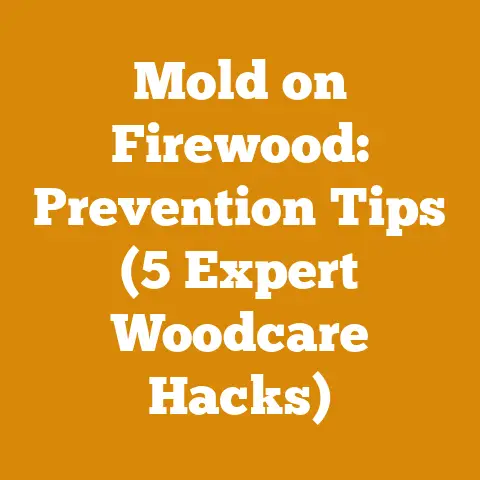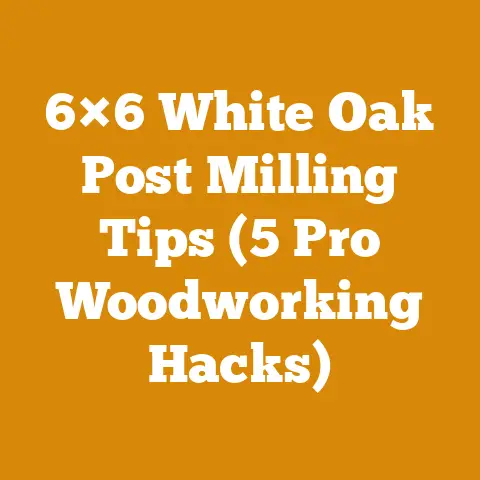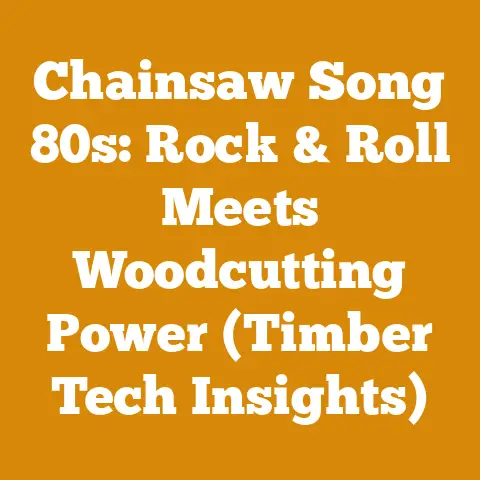Price for Stump Grinding: (5 Expert Tips to Maximize Your Earnings)
I’ve always found stump grinding to be a fascinating niche within the broader world of tree care and wood processing. It’s not just about removing an unsightly leftover; it’s about reclaiming space, preventing hazards, and even improving the soil. But, like any specialized service, pricing it right is crucial for profitability and client satisfaction. Over the years, I’ve seen many operators undersell themselves or, conversely, price themselves out of the market. This guide is born from my experiences, observations, and a fair bit of trial and error. I’m going to share five expert tips to help you maximize your earnings in stump grinding, ensuring you’re not leaving money on the table.
Price for Stump Grinding: 5 Expert Tips to Maximize Your Earnings
1. Understanding the Stump Grinding Landscape
Before diving into pricing strategies, it’s essential to grasp the fundamentals of stump grinding and the factors influencing its cost.
What is Stump Grinding?
Stump grinding is the process of mechanically removing tree stumps using a specialized machine called a stump grinder. These machines typically feature a rotating cutting wheel with hardened teeth that grind the stump into small chips. The resulting chips can then be used as mulch, composted, or hauled away.
Key Factors Influencing Stump Grinding Costs
Several factors contribute to the price of stump grinding, and understanding them is crucial for accurate quoting:
- Stump Size: This is the most significant factor. Larger stumps require more time and effort to grind. Diameter is the primary measurement, but height above ground and root flare also matter.
- Stump Quantity: Multiple stumps on a property will affect the overall price, often with discounts for volume.
- Stump Accessibility: Stumps in difficult-to-reach locations (e.g., behind fences, on steep slopes, near buildings) require more time and specialized equipment, increasing costs.
- Stump Species: Harder wood species (e.g., oak, hickory) take longer to grind than softer woods (e.g., pine, poplar).
- Root System: The extent of the root system can impact grinding time, especially for species known for extensive lateral roots.
- Soil Conditions: Rocky or sandy soil can damage the grinding teeth, leading to increased wear and tear and potentially higher costs.
- Underground Obstacles: Utility lines, buried concrete, or other obstacles can complicate the grinding process and increase the price.
- Cleanup: Removing the stump grindings and restoring the area adds to the overall cost.
- Travel Distance: The distance to the job site affects fuel costs and travel time, which should be factored into the price.
- Disposal Costs: If you haul away the grindings, consider disposal fees at local landfills or composting facilities.
Common Stump Grinding Pricing Models
There are two primary pricing models used in the stump grinding industry:
- Per-Stump Pricing: This is the most common model, where you charge a fixed price for each stump based on its size and complexity. It’s straightforward for both you and the client.
- Hourly Pricing: This model involves charging an hourly rate for your time and equipment. It’s often used for larger jobs with numerous stumps or when the scope of work is difficult to estimate upfront.
I’ve personally found that a hybrid approach often works best. I use per-stump pricing for most jobs, but I reserve the right to switch to an hourly rate if I encounter unexpected complications or the job takes significantly longer than anticipated. This protects me from losing money on difficult jobs while still providing the client with a clear upfront price.
2. Accurate Stump Measurement and Assessment
The foundation of accurate pricing is precise measurement and a thorough assessment of the stump and its surroundings. This goes beyond simply eyeballing the diameter.
Tools for Accurate Measurement
- Measuring Tape: A standard measuring tape is essential for determining the stump diameter at its widest point. I recommend using a tape measure that’s at least 25 feet long.
- Laser Distance Measurer: For larger properties or stumps in difficult-to-reach locations, a laser distance measurer can be a valuable tool. It allows you to quickly and accurately measure distances without having to physically access the stump.
- Smartphone with Measurement Apps: Many smartphone apps can estimate distances and areas using the phone’s camera. While not as precise as a measuring tape or laser distance measurer, they can be useful for initial assessments.
Steps for Measuring Stump Size and Assessing Conditions
- Measure the Diameter: Use your measuring tape to determine the stump’s diameter at its widest point. If the stump is irregularly shaped, take multiple measurements and average them.
- Estimate Root Flare: Observe the root flare, which is the widening of the stump at its base where the roots emerge. This area will also need to be ground, so estimate its diameter as well. You can measure this with the measuring tape as well, or even use the laser measurer if the flare is extensive.
- Assess Accessibility: Evaluate the accessibility of the stump. Are there any obstacles that will hinder your ability to maneuver the stump grinder? Are there fences, buildings, or other structures in the way? Is the stump located on a steep slope or in a confined space?
- Identify the Wood Species: Determine the species of the tree. This will give you an idea of the wood’s hardness and how long it will take to grind. If you’re unsure, take a sample of the wood and consult a tree identification guide or a local arborist.
- Check for Underground Obstacles: Inquire with the client about any underground utilities or other obstacles that may be present near the stump. You can also contact your local “Call Before You Dig” service to have the area marked for utilities. Remember, safety first!
- Evaluate Soil Conditions: Examine the soil around the stump. Is it rocky, sandy, or clay-rich? Rocky soil can damage the grinding teeth, while sandy soil can be abrasive.
- Note the Number of Stumps: Count the number of stumps to be ground. Multiple stumps may warrant a volume discount.
- Estimate Cleanup Requirements: Assess the amount of cleanup that will be required after grinding. Will the grindings need to be hauled away, or can they be used as mulch on the property? Will the area need to be restored with topsoil and seed?
Case Study: The Hidden Boulder
I once quoted a job based on the visible portion of the stump. It was a medium-sized oak stump, about 24 inches in diameter. The price was set, and I started grinding. About an hour in, I hit something hard. Turns out, the stump was partially buried, and a large boulder was intertwined with the root system. This significantly increased the grinding time and the wear on my machine. Luckily, I had a clause in my contract allowing me to adjust the price if unforeseen circumstances arose. I explained the situation to the client, showed them the boulder, and we agreed on a revised price. This experience taught me the importance of thoroughly assessing the area around the stump before providing a quote.
3. Calculating Your Costs and Profit Margin
Understanding your costs is fundamental to setting profitable prices. You need to know exactly how much it costs you to operate your business, including both fixed and variable expenses.
Identifying Fixed Costs
Fixed costs are expenses that remain relatively constant regardless of the number of jobs you complete. These include:
- Equipment Depreciation: The gradual decline in value of your stump grinder and other equipment over time.
- Insurance: Liability insurance, workers’ compensation insurance (if you have employees), and equipment insurance.
- Vehicle Payments/Lease: Monthly payments for your truck or trailer.
- Business Licenses and Permits: Fees for operating your business legally.
- Advertising and Marketing: Costs associated with promoting your services.
- Office Expenses: Rent, utilities, phone, internet, and software.
To calculate your fixed costs per job, estimate your total fixed costs for a year and divide by the number of jobs you expect to complete.
Calculating Variable Costs
Variable costs are expenses that fluctuate depending on the number of jobs you complete. These include:
- Fuel: The cost of gasoline or diesel for your truck and stump grinder.
- Grinding Teeth: The cost of replacing worn or damaged grinding teeth.
- Maintenance and Repairs: Expenses for maintaining and repairing your equipment.
- Disposal Fees: Fees for disposing of stump grindings at landfills or composting facilities.
- Labor Costs: Wages for yourself and any employees.
- Travel Time: The cost of your time spent traveling to and from job sites.
To calculate your variable costs per job, track your expenses for a period of time (e.g., a month or a quarter) and divide by the number of jobs you completed during that period.
Determining Your Desired Profit Margin
Your profit margin is the percentage of revenue that remains after deducting all costs. It’s essential to set a profit margin that allows you to cover your expenses, invest in your business, and earn a reasonable income.
A good starting point is to aim for a profit margin of 20-30%. However, this may vary depending on your local market, the level of competition, and the type of jobs you typically complete.
Sample Cost Calculation
Let’s say your annual fixed costs are $20,000, and you expect to complete 200 jobs per year. Your fixed cost per job would be $100.
Your variable costs per job might include:
- Fuel: $20
- Grinding Teeth: $10
- Maintenance: $5
- Disposal Fees: $15
- Labor: $30
Your total variable cost per job would be $80.
Adding your fixed and variable costs together, your total cost per job would be $180.
If you want to achieve a 25% profit margin, you would need to charge $240 per job ($180 / (1 – 0.25)).
Using Cost Data for Pricing
Once you have a handle on your costs, you can use this information to set your prices. I recommend creating a pricing sheet that lists the different stump sizes and their corresponding prices. You can then adjust these prices based on the specific factors of each job, such as accessibility, species, and soil conditions.
4. Setting Competitive Prices in Your Market
While knowing your costs is critical, you also need to be aware of what your competitors are charging. Pricing too high can drive customers away, while pricing too low can erode your profit margin.
Dynamic Pricing Strategies
- Promotional Pricing: Offer discounts or special promotions to attract new customers or fill slow periods.
- Tiered Pricing: Offer different levels of service at different price points. For example, you could offer a basic service that includes grinding the stump and leaving the grindings on-site, and a premium service that includes hauling away the grindings and restoring the area.
- Negotiation: Be willing to negotiate your prices, especially for larger jobs or repeat customers.
5. Maximizing Efficiency and Minimizing Costs
The most effective way to maximize your earnings is to improve your efficiency and reduce your costs. This involves optimizing your workflow, investing in the right equipment, and minimizing waste.
By implementing these five expert tips, you can maximize your earnings in stump grinding and build a successful and profitable business. Remember that it’s not just about the price; it’s about the value you provide to your clients. Focus on delivering excellent service, building strong relationships, and continuously improving your efficiency, and you’ll be well on your way to success.






